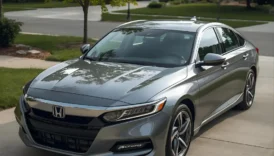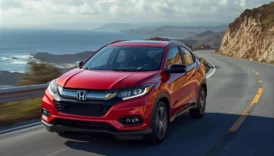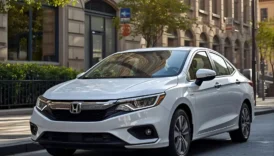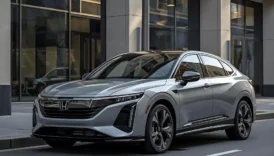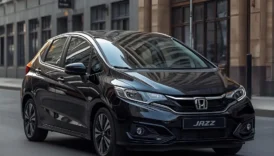2024 Honda CR-V: Essential Features Guide
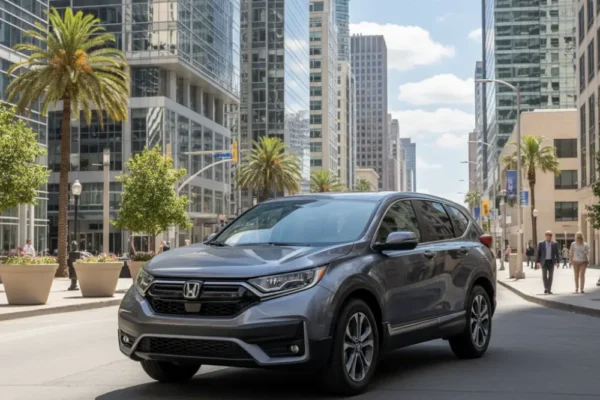
- 2024 Honda CR-V: Essential Features Guide
- What’s New in the 2024 Honda CR-V?
- Key Updates for 2024
- Positioning in the Segment
- Why These Updates Matter
- Engine Options, Hybrid Performance, and Efficiency
- Gasoline Engine: Proven and Reliable
- Hybrid Powertrain: More Trims, More Efficiency
- All-Wheel Drive Capability
- Performance and Driving Impressions
- Towing Capacity
- Driving Experience and Handling Characteristics
- Steering and Ride Quality
- Handling Dynamics
- Urban Driving and Maneuverability
- Highway Stability and Comfort
- Overall Driving Feel
- Interior Comfort and Practical Features
- Cabin Design and Layout
- Seating Comfort and Space
- Practical Storage Solutions
- Climate and Cabin Quietness
- Technology Integration
- Overall Cabin Experience
- Safety Systems and Honda Sensing Technology
- Structural Safety and Passive Protection
- Standard Honda Sensing® Features
- Advanced Safety and Driver Assistance Options
- Real-World Safety Performance
- Overall Safety Impression
- Infotainment and Connectivity Features
- Display and Interface
- Smartphone Integration
- Navigation and Audio Systems
- Over-the-Air (OTA) Updates
- Instrument Cluster and Driver Info Display
- Overall Infotainment Experience
- Fuel Economy and Real-World Efficiency
- Gasoline Engine Efficiency
- Hybrid Powertrain Efficiency
- Real-World Efficiency Factors
- Eco Modes and Driving Behavior
- Overall Efficiency Outlook
- Common Problems and Reliability Insights
- Infotainment and Connectivity Glitches
- Honda Sensing® Sensitivity
- Hybrid System Observations
- Interior Fit and Finish
- Powertrain and Mechanical Reliability
- Overall Reliability Outlook
- Maintenance Schedule and Ownership Practicalities
- Standard Maintenance Intervals
- Hybrid vs. Gasoline Maintenance
- Digital Service Tracking and Reminders
- Long-Term Ownership Costs
- Practical Ownership Features
- Overall Ownership Outlook
- Dimensions, Cargo Capacity, and Everyday Usability
- Exterior and Interior Dimensions
- Cargo Capacity and Flexibility
- Everyday Urban Usability
- Practical Storage Solutions
- Overall Usability
- Frequently Asked Questions About the 2024 Honda CR-V
- What engines and powertrains are available for the 2024 Honda CR-V?
- How fuel-efficient is the 2024 Honda CR-V?
- Is the 2024 Honda CR-V a reliable SUV?
- Are there any common problems with the 2024 Honda CR-V?
- What safety features are standard on the 2024 Honda CR-V?
- How much cargo space does the 2024 Honda CR-V offer?
- What is the recommended maintenance schedule for the 2024 CR-V?
The 2024 Honda CR-V continues its legacy as one of the most popular and well-rounded compact SUVs on the market. Known for its strong reliability, spacious interior, and excellent fuel economy, the latest CR-V combines practicality with a refined driving experience. Available with gasoline and hybrid powertrains, the 2024 model emphasizes efficiency without sacrificing comfort or technology. With Honda Sensing safety features standard across the lineup and an upgraded interior, this SUV is designed to meet the needs of families, commuters, and adventurers alike. In this comprehensive guide, we’ll break down its performance, features, reliability, and real-world usability.
What’s New in the 2024 Honda CR-V?
The 2024 Honda CR-V continues the sixth generation introduced in 2023, but it comes with subtle refinements and equipment updates that make it more attractive to modern SUV buyers. While the overall design and platform remain the same, Honda has fine-tuned features, safety tech, and powertrain availability to keep the CR-V competitive in a crowded segment.
Key Updates for 2024
- Expanded Hybrid Availability: The hybrid powertrain is now offered on more trims, making it easier for buyers to choose a more efficient version without sacrificing features.
- Updated Honda Sensing Suite: The advanced driver-assistance package receives software refinements, resulting in smoother adaptive cruise control and more precise lane-keeping behavior.
- Enhanced Interior Technology: Trims with the larger infotainment screen now feature wireless Apple CarPlay and Android Auto as standard, while OTA update capability has been expanded for system improvements.
- Small Design Tweaks: Minor exterior styling adjustments, including new wheel designs and updated color options, give the CR-V a fresh yet familiar appearance.
- Improved Cabin Insulation: Honda has added extra sound-deadening materials, making the 2024 CR-V quieter on highways and in urban driving.
Positioning in the Segment
The CR-V remains one of the best-selling compact SUVs globally, competing with models like the Toyota RAV4, Mazda CX-5, Hyundai Tucson, and Kia Sportage. Its combination of spacious interior, strong resale value, and excellent reliability keeps it at the top of many buyers’ lists.
Why These Updates Matter
These refinements make the 2024 Honda CR-V even more compelling by enhancing efficiency, safety, and in-cabin experience without raising complexity. It builds on its proven platform with thoughtful upgrades rather than radical changes — a strategy that has historically worked well for Honda.
Engine Options, Hybrid Performance, and Efficiency
The 2024 Honda CR-V offers buyers a choice between a refined gasoline engine and a high-efficiency hybrid powertrain, both designed to deliver smooth performance and excellent real-world economy. Honda’s focus for this generation is to improve drivability, reduce emissions, and enhance everyday usability, making the CR-V a smart choice for a wide range of drivers.
Gasoline Engine: Proven and Reliable
Standard on lower trims, the gasoline powertrain consists of:
- Engine: 1.5-liter turbocharged inline-4
- Power: 190 hp @ 6,000 rpm
- Torque: 179 lb-ft @ 1,700–5,000 rpm
- Transmission: Continuously Variable Transmission (CVT)
- Drivetrain: Standard FWD, optional AWD
This engine is well-known in Honda’s lineup for its smooth, linear power delivery and reliability. It provides adequate acceleration for everyday driving, with refined behavior in urban traffic and highway conditions. The CVT is tuned to mimic traditional gear shifts, improving driver engagement without sacrificing efficiency.
Hybrid Powertrain: More Trims, More Efficiency
The two-motor hybrid system is now available on more trims in 2024, making it a central part of the CR-V lineup.
- Engine + Motors: 2.0-liter Atkinson-cycle inline-4 + two electric motors
- Total System Power: 204 hp
- Torque: 247 lb-ft
- Transmission: e-CVT (Electronically Controlled Continuously Variable Transmission)
- Drivetrain: FWD or AWD, depending on trim
This hybrid setup is tuned for efficiency and smoothness. Unlike some hybrids that rely heavily on the gasoline engine, the CR-V Hybrid can operate in electric-only mode at low speeds and seamlessly transition between gas, electric, or a combination depending on conditions. The result is quiet operation in the city, strong low-end torque, and significant fuel savings.
All-Wheel Drive Capability
Both gasoline and hybrid versions offer optional Real Time AWD with Intelligent Control System™, which can transfer power to the rear wheels automatically when slip is detected. This improves traction on wet, snowy, or uneven roads without requiring manual input. The system is tuned to engage quickly and smoothly, maintaining stability and driver confidence.
Performance and Driving Impressions
- The gasoline model delivers predictable, smooth power suitable for families and daily commuting.
- The hybrid model feels more responsive off the line thanks to instant electric torque, making it ideal for urban traffic and highway merging.
- Both variants prioritize refinement over sportiness, aligning with the CR-V’s reputation as a comfortable, family-oriented SUV.
Towing Capacity
- Gasoline version: Up to 1,500 lbs (680 kg)
- Hybrid version: Up to 1,000 lbs (454 kg)
While not a heavy-duty tow vehicle, the CR-V can comfortably handle small trailers, bikes, or light recreational equipment.
Driving Experience and Handling Characteristics
The 2024 Honda CR-V focuses on delivering a balanced and refined driving experience, making it one of the most comfortable and predictable compact SUVs in its class. Whether equipped with the gasoline or hybrid powertrain, the CR-V excels in ride comfort, stability, and everyday usability, appealing to both families and commuters alike.
Steering and Ride Quality
The CR-V uses an electric power steering system tuned for light, precise control at low speeds and confident stability on the highway.
- Urban driving: The steering feels light and easy, allowing smooth navigation through tight streets, parking lots, and congested traffic.
- Highway cruising: At higher speeds, the steering firms up, giving a planted and secure feel behind the wheel.
The suspension setup is one of the highlights of the 2024 CR-V. Featuring MacPherson struts at the front and a multi-link independent rear suspension, it delivers a smooth, composed ride that soaks up bumps and uneven pavement effectively. This suspension tuning strikes a near-perfect balance between comfort and control.
Handling Dynamics
While the CR-V is not designed as a sporty SUV, its rigid platform and well-calibrated chassis provide predictable and stable handling in all conditions:
- Cornering: Body roll is well-controlled, giving the CR-V a stable, confident feel even through sweeping curves.
- Hybrid version: The battery pack is mounted low in the chassis, lowering the center of gravity slightly and enhancing stability during cornering.
- AWD models: Offer improved grip and composure on wet or slippery surfaces, engaging the rear wheels automatically when needed.
The result is an SUV that feels secure and planted, even during sudden maneuvers or emergency lane changes.
Urban Driving and Maneuverability
The CR-V’s compact exterior dimensions combined with excellent visibility make it easy to drive in crowded city environments:
- Tight turning radius simplifies U-turns and parking garage navigation.
- Available 360° camera system (on upper trims) assists with precise maneuvering in tight spaces.
- Smooth throttle response in both gasoline and hybrid versions makes stop-and-go traffic less tiring.
Highway Stability and Comfort
On the highway, the CR-V truly shines:
- Quiet cabin: Enhanced insulation for 2024 reduces wind and road noise, improving overall comfort on long drives.
- Stable tracking: The SUV remains steady even in crosswinds, with minimal steering corrections needed.
- Adaptive cruise control and lane centering (part of Honda Sensing) reduce driver fatigue on extended journeys.
Overall Driving Feel
The 2024 Honda CR-V delivers a smooth, refined, and confidence-inspiring drive. It’s not built for thrill-seekers, but for those who prioritize comfort, predictability, and ease of use, it remains one of the best-balanced compact SUVs available. The hybrid variant adds a touch of extra responsiveness, making it especially pleasant in urban settings.
Interior Comfort and Practical Features
The 2024 Honda CR-V interior continues to build on the model’s reputation for spaciousness, functionality, and comfort. Honda has refined the cabin layout to feel more upscale and ergonomic, while retaining the practical storage solutions and thoughtful touches that make the CR-V one of the most family-friendly SUVs on the market.
Cabin Design and Layout
The CR-V’s cabin adopts a clean, horizontal design language, similar to the latest Civic and Accord:
- A mesh accent strip spans the dashboard, concealing the air vents for a minimalist, premium look.
- Physical knobs for climate and volume remain, offering intuitive, distraction-free control.
- Materials have been upgraded with soft-touch surfaces, high-quality plastics, and available leather upholstery on upper trims.
- The cabin’s design emphasizes airiness and simplicity, making it inviting and uncluttered.
Seating Comfort and Space
The front seats are wide and supportive, designed for long drives:
- Standard 8-way power-adjustable driver’s seat with lumbar support on most trims
- Available heated front seats, ventilated front seats (on higher trims), and memory settings
- Rear seats offer exceptional legroom for the segment, with a reclining backrest for added comfort on longer journeys.
- Cabin width provides ample shoulder room for three adults in the back without feeling cramped.
Thanks to the CR-V’s tall roofline and smart packaging, the cabin feels open and airy, even with a panoramic sunroof installed on higher trims.
Practical Storage Solutions
Honda is known for smart interior packaging, and the CR-V excels here:
- Massive center console with configurable dividers for bags, tablets, or small items
- Deep door bins that can accommodate large bottles
- Rear seatback pockets for passengers
- Multiple USB-A and USB-C charging ports throughout the cabin
- Wireless charging pad available on upper trims for added convenience
Every storage space is designed to be usable and accessible, reflecting Honda’s attention to daily practicality.
Climate and Cabin Quietness
The dual-zone automatic climate control system ensures consistent comfort for all passengers, with rear vents standard on most trims. For 2024, Honda has added extra sound-deadening materials in the doors, floor, and firewall, making the CR-V’s cabin noticeably quieter on the highway compared to previous years.
Technology Integration
Even though this section focuses on comfort, it’s worth noting how technology enhances usability inside:
- Digital driver display provides clear information without clutter.
- Infotainment screen placement is ergonomically optimized to minimize eye movement.
- Higher trims include hands-free power tailgate and proximity key entry, making loading and unloading smoother.
Overall Cabin Experience
The 2024 Honda CR-V interior delivers a rare mix of comfort, clever functionality, and premium touches in the compact SUV segment. Whether you’re commuting solo, carrying kids, or loading up for a weekend trip, the CR-V provides a versatile and thoughtfully designed environment that adapts to your daily needs.
Safety Systems and Honda Sensing Technology
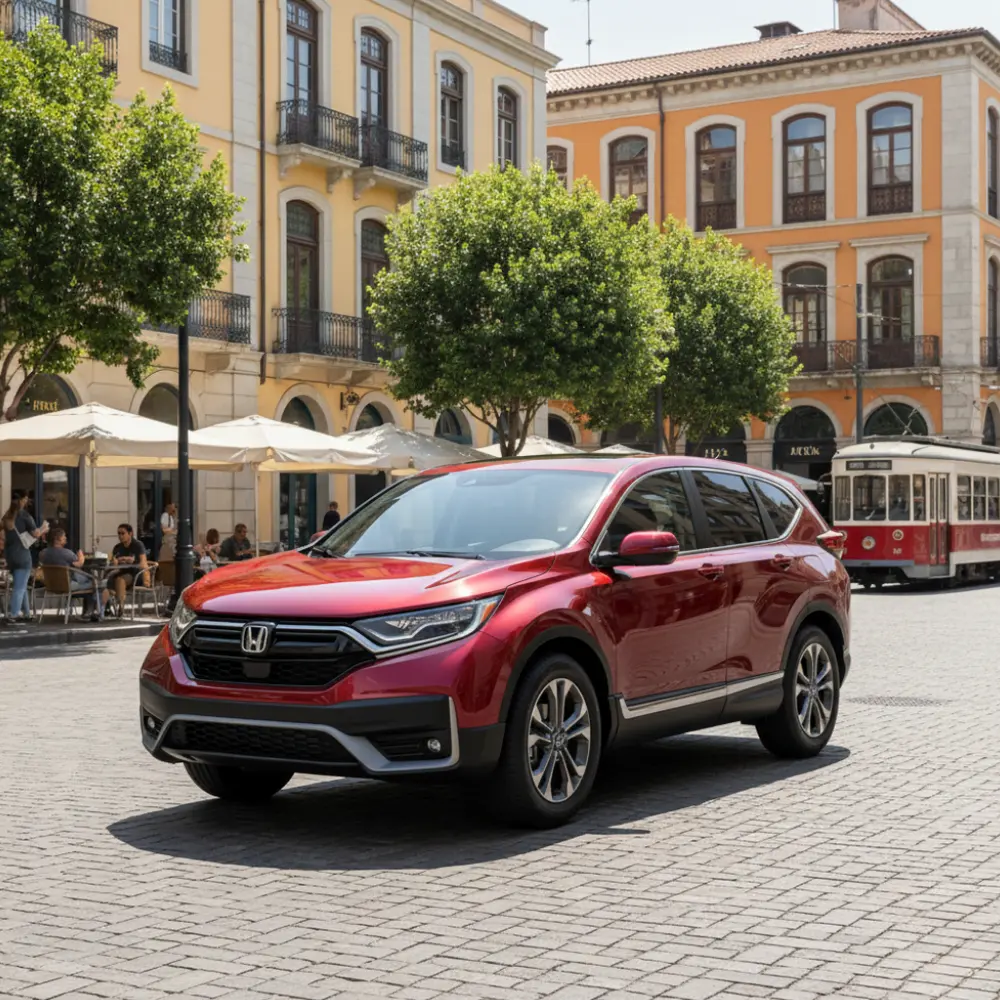
The 2024 Honda CR-V continues Honda’s long-standing reputation for class-leading safety, combining a rigid platform, advanced passive protection, and an updated suite of Honda Sensing® driver-assistance technologies. Safety is standard across all trims, ensuring that every CR-V buyer benefits from the same high level of protection.
Structural Safety and Passive Protection
The CR-V is built on Honda’s Advanced Compatibility Engineering™ (ACE™) body structure, which distributes crash energy more evenly across the front of the vehicle to better protect occupants in collisions. Key passive safety elements include:
- Front, side, curtain, and knee airbags
- Anti-lock Braking System (ABS) with Electronic Brake Distribution (EBD)
- Vehicle Stability Assist™ (VSA®) with traction control
- Tire Pressure Monitoring System (TPMS)
- ISOFIX/LATCH anchors for child seats
The rigid platform also improves handling stability and reduces cabin deformation during impacts, contributing to excellent crash test performance globally.
Standard Honda Sensing® Features
All 2024 CR-V models come with Honda Sensing® as standard, which includes:
- Collision Mitigation Braking System™ (CMBS™) – detects potential frontal collisions and applies brakes automatically if necessary.
- Road Departure Mitigation System (RDM) – alerts the driver and can apply steering corrections to prevent lane departure.
- Adaptive Cruise Control (ACC) – maintains a set following distance, now with smoother acceleration and braking in traffic.
- Lane Keeping Assist System (LKAS) – keeps the vehicle centered in its lane.
- Forward Collision Warning (FCW) and Lane Departure Warning (LDW) systems for early alerts.
For 2024, Honda has refined the software behind these systems, improving responsiveness and reducing unnecessary alerts in complex road situations.
Advanced Safety and Driver Assistance Options
Higher trims offer additional safety features, enhancing convenience and confidence:
- Low-Speed Braking Control – detects obstacles when maneuvering at low speeds and applies brakes automatically.
- Blind Spot Information System with Cross Traffic Monitor – alerts the driver to vehicles in adjacent lanes or approaching from the sides when reversing.
- Traffic Sign Recognition – displays detected speed limit signs on the instrument panel.
- 360° Camera System – available on top trims, offering a bird’s-eye view for easier parking in tight spaces.
Real-World Safety Performance
In crash testing, the CR-V consistently scores top safety ratings:
- IIHS: Top Safety Pick+
- NHTSA: 5-Star Overall Safety Rating
- Excellent performance in side-impact, small overlap, and rollover categories
Honda’s active driver aids work smoothly in real-world conditions. Adaptive cruise control maintains comfortable gaps in traffic, lane-keeping is more accurate than previous years, and blind spot monitoring is well-calibrated, minimizing false alerts.
Overall Safety Impression
The 2024 Honda CR-V delivers one of the most comprehensive and reliable safety packages in the compact SUV market. By combining robust engineering with advanced active safety, it offers exceptional protection for both driver and passengers—whether in urban traffic or on long highway drives.
Infotainment and Connectivity Features
The 2024 Honda CR-V offers a well-balanced infotainment system that combines ease of use, modern connectivity, and essential features without overwhelming the driver. For 2024, Honda has improved the wireless integration, software responsiveness, and OTA update capability, making the system feel more up-to-date and user-friendly.
Display and Interface
The CR-V offers two infotainment screen sizes depending on the trim level:
- 7-inch touchscreen (standard on base trims): Simple, intuitive interface with physical volume and tuning knobs for ease of use.
- 9-inch touchscreen (standard on higher trims): Provides a clean, tile-based menu, faster processing, and improved clarity with anti-glare coating.
Both displays are mounted high on the dashboard, minimizing the time drivers spend looking away from the road. Honda keeps the interface straightforward, avoiding unnecessary submenus and relying on physical controls where appropriate.
Smartphone Integration
Honda has made wireless connectivity standard on trims equipped with the 9-inch display:
- Wireless Apple CarPlay® and Android Auto™ for seamless smartphone mirroring
- Wired Apple CarPlay® and Android Auto™ remain available on the 7-inch system
- Bluetooth® 5.0 for fast, stable device pairing
- Multiple USB-A and USB-C ports in the front and rear for quick charging
- Wireless charging pad is available on higher trims, positioned conveniently below the center stack
This combination ensures that whether you prefer wired or wireless integration, your smartphone connects quickly and reliably.
Navigation and Audio Systems
- Built-in Navigation (available on upper trims) uses real-time traffic updates and is displayed clearly on the 9-inch screen, minimizing lag and unnecessary steps.
- Voice commands can control navigation, media, and phone functions, with improved natural language understanding.
- Audio Systems:
- Standard: 4- to 6-speaker setup, depending on trim
- Premium: 12-speaker Bose® Premium Audio System with subwoofer on top trims, providing rich, immersive sound quality that rivals more expensive SUVs.
Over-the-Air (OTA) Updates
One of the key upgrades for 2024 is expanded OTA update capability, allowing Honda to deliver:
- Software bug fixes
- Interface improvements
- Feature enhancements
This ensures the infotainment system remains up to date over time, reducing the need for dealership visits for minor updates.
Instrument Cluster and Driver Info Display
The 7-inch digital driver display, standard across all trims, shows essential information like speed, driver-assistance status, navigation directions, and media details. Higher trims can display turn-by-turn navigation directly in the cluster, reducing driver distraction.
Overall Infotainment Experience
The 2024 Honda CR-V doesn’t chase gimmicks—it focuses on clarity, responsiveness, and practicality. The larger screen, wireless smartphone integration, OTA updates, and premium audio on higher trims combine to deliver a modern, connected, and easy-to-use system that enhances daily driving without overcomplicating it.
Fuel Economy and Real-World Efficiency
The 2024 Honda CR-V is designed with efficiency at its core, offering excellent fuel economy across both gasoline and hybrid variants. With aerodynamic refinements, powertrain tuning, and the availability of a two-motor hybrid system, the CR-V delivers real-world savings without compromising comfort or performance.
Gasoline Engine Efficiency
The 1.5-liter turbocharged gasoline engine remains impressively frugal for a non-hybrid SUV, thanks to efficient CVT tuning and lightweight design.
Estimated EPA ratings for the gasoline FWD model:
- City: 28 mpg (8.4 L/100 km)
- Highway: 34 mpg (6.9 L/100 km)
- Combined: 30 mpg (7.8 L/100 km)
With AWD, those figures are slightly lower but still competitive:
- City: 27 mpg (8.7 L/100 km)
- Highway: 32 mpg (7.4 L/100 km)
- Combined: 29 mpg (8.1 L/100 km)
Honda has refined the CVT behavior to allow low engine revs at cruising speeds, maximizing highway efficiency.
Hybrid Powertrain Efficiency
The two-motor hybrid system is where the CR-V truly shines in fuel economy.
EPA estimates for the Hybrid FWD version:
- City: 43 mpg (5.5 L/100 km)
- Highway: 36 mpg (6.5 L/100 km)
- Combined: 40 mpg (5.9 L/100 km)
For Hybrid AWD, the numbers remain impressive:
- City: 40 mpg (5.9 L/100 km)
- Highway: 34 mpg (6.9 L/100 km)
- Combined: 37 mpg (6.4 L/100 km)
This places the CR-V Hybrid among the most fuel-efficient non-plug-in SUVs in its class, rivaling hybrid versions of the Toyota RAV4 and Hyundai Tucson.
Real-World Efficiency Factors
Drivers consistently report real-world fuel economy close to or exceeding EPA estimates, especially for hybrids in city driving where the electric motors handle a significant portion of propulsion. Contributing factors include:
- Regenerative braking, which captures energy during deceleration
- EV-only mode at low speeds, reducing engine use in traffic
- Lightweight chassis that reduces rolling resistance
- Active grille shutters and aerodynamic mirrors to minimize drag
Eco Modes and Driving Behavior
The CR-V offers selectable drive modes that influence efficiency:
- Econ Mode: Softens throttle response and optimizes HVAC to maximize fuel economy.
- Normal Mode: Balanced response for everyday driving.
- Sport Mode (Hybrid): Increases throttle sensitivity and holds revs longer for a more engaging drive.
Hybrid models particularly benefit from Eco Mode in urban conditions, extending electric-only operation.
Overall Efficiency Outlook
With its gasoline engine returning up to 34 mpg highway and hybrid system achieving around 40 mpg combined, the 2024 Honda CR-V stands out as one of the most efficient compact SUVs available. Whether you choose the standard engine or the hybrid, you can expect excellent real-world economy, making the CR-V a strong choice for drivers who value long-term savings without sacrificing versatility.
Common Problems and Reliability Insights
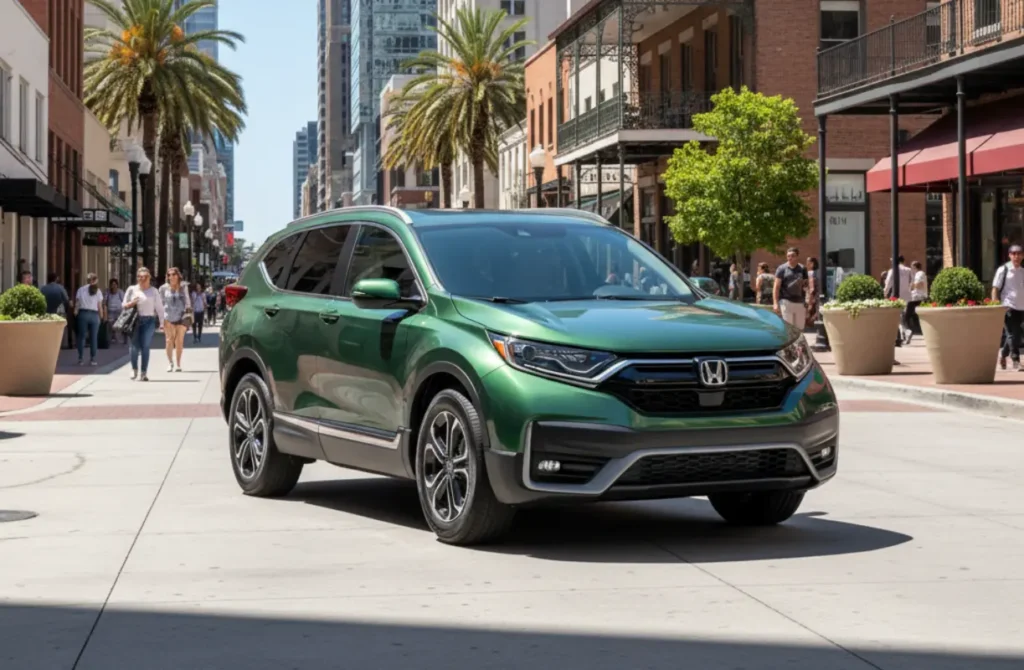
The 2024 Honda CR-V benefits from decades of proven engineering and remains one of the most reliable compact SUVs on the market. Built on the sixth-generation platform introduced in 2023, it carries over most components with minimal changes, meaning early production issues have largely been ironed out. While no widespread problems have emerged, there are a few minor observations worth noting regarding software behavior, interior fittings, and early hybrid quirks.
Infotainment and Connectivity Glitches
Some early owners have reported occasional wireless Apple CarPlay® and Android Auto™ connection drops, particularly on the 9-inch screen models. These are typically brief and resolved by:
- Restarting the infotainment system, or
- Installing over-the-air (OTA) software updates, which Honda has begun rolling out regularly.
Other rare issues include temporary audio lag in Bluetooth playback and slight screen freezing in very cold weather. None of these are critical, and Honda’s OTA capability significantly reduces the need for dealership visits.
Honda Sensing® Sensitivity
The 2024 CR-V uses a single-camera + radar setup for its Honda Sensing® suite. While generally reliable, a few users note occasional over-sensitivity in:
- Lane departure warnings on narrow or poorly marked roads
- Adaptive cruise control in heavy stop-and-go traffic, sometimes braking a bit too firmly
These behaviors are typically software calibration quirks, not hardware faults. Honda continues to refine the system through updates.
Hybrid System Observations
The two-motor hybrid system has proven durable, but some drivers report:
- A slight shudder or delay when transitioning between electric and gas power at very low speeds (e.g., in parking lots).
- Regenerative braking feel that can be a bit grabby at low speeds until the driver adapts.
- Occasional battery management system alerts caused by software miscommunication, typically cleared with updates.
These issues are uncommon and do not indicate systemic hybrid reliability problems.
Interior Fit and Finish
While build quality is excellent overall, a few owners have noticed:
- Minor rattles around the dashboard or panoramic sunroof area on rough roads
- Squeaks from interior trim in colder temperatures as materials contract
- Easy fixes during routine service or under warranty
Powertrain and Mechanical Reliability
Both the 1.5-liter turbo engine and the two-motor hybrid system are proven, widely used powertrains with strong long-term reliability. Honda’s CVT is well-tuned and has a solid track record when fluid changes are performed at recommended intervals. AWD components are robust and require minimal maintenance.
Overall Reliability Outlook
The 2024 Honda CR-V continues to stand out for its low incidence of serious mechanical issues. Most reported concerns are software or minor fit-related, which Honda addresses through OTA updates or warranty adjustments. Given its strong powertrain history, meticulous engineering, and consistent global production standards, the CR-V remains a top pick for buyers seeking durability and hassle-free ownership.
Maintenance Schedule and Ownership Practicalities
The 2024 Honda CR-V is engineered for low ownership costs and straightforward maintenance, a key factor behind its enduring popularity. Whether you choose the gasoline or hybrid model, Honda’s reliable powertrains, predictable service intervals, and digital maintenance tracking make it one of the most cost-effective SUVs to own over the long term.
Standard Maintenance Intervals
Honda uses its Maintenance Minder™ system, which monitors driving habits, mileage, and conditions to alert owners when service is due. Typical service intervals include:
- Engine oil and filter: Every 12 months or 12,000–15,000 km (7,500–9,000 miles) depending on conditions
- Tire rotation: Every 10,000–12,000 km (6,000–7,500 miles)
- Air filter and cabin filter: Every 24,000–30,000 km (15,000–18,000 miles)
- Brake fluid replacement: Every 3 years regardless of mileage
- CVT fluid (gasoline models): Around 50,000–60,000 km (30,000–37,000 miles), depending on usage
- Hybrid coolant and system check: Typically every 160,000 km (100,000 miles) or as indicated by the system
These intervals are clear, simple, and often longer than competitors, reducing both maintenance frequency and costs.
Hybrid vs. Gasoline Maintenance
One of the advantages of the two-motor hybrid system is reduced wear on engine and braking components:
- Regenerative braking reduces brake pad wear, often doubling their lifespan compared to non-hybrid models.
- The hybrid system’s electric assistance lowers engine stress, leading to less frequent mechanical repairs over time.
- Hybrid systems have no traditional alternator or starter motor, reducing the number of moving parts.
Routine checks on the high-voltage system are typically software-based and do not require expensive interventions.
Digital Service Tracking and Reminders
All 2024 CR-V models come equipped with HondaLink®, allowing owners to:
- View upcoming service intervals through the app
- Receive push notifications for maintenance reminders
- Track service history digitally for resale transparency
- Schedule service appointments directly with dealers
This digital integration simplifies ownership and helps maintain the vehicle’s strong resale value.
Long-Term Ownership Costs
The CR-V has long been recognized as one of the lowest-cost SUVs to own, thanks to:
- Exceptional fuel economy, especially on hybrid models
- Fewer major service requirements compared to turbocharged competitors with more complex drivetrains
- Excellent parts availability and low labor times for routine maintenance
- Strong resale and reliability reputation, which lowers total cost of ownership
Honda’s hybrid batteries are designed to last the lifetime of the vehicle under normal use, and they come with long warranty coverage (typically 8 years / 160,000 km or more, depending on the region).
Practical Ownership Features
- Easy DIY checks: Fluid levels, filters, and tire pressure are easily accessible for owners who prefer basic self-maintenance.
- Widespread dealer network: Ensures convenient servicing almost anywhere.
- Simple service structure: No hidden complexity—just predictable, transparent maintenance needs.
Overall Ownership Outlook
The 2024 Honda CR-V is among the most maintenance-friendly SUVs in its class. Whether hybrid or gasoline, it combines long service intervals, digital support, and Honda’s renowned reliability to deliver a low-stress, low-cost ownership experience that appeals to both families and daily commuters.
Dimensions, Cargo Capacity, and Everyday Usability
The 2024 Honda CR-V excels in interior space, cargo flexibility, and everyday practicality, making it one of the most versatile options in the compact SUV segment. Honda has carefully balanced urban maneuverability with family-friendly dimensions, ensuring the CR-V remains easy to drive while offering generous room for passengers and luggage.
Exterior and Interior Dimensions
The 2024 CR-V rides on the same platform introduced in 2023, offering slightly larger proportions than previous generations:
- Length: 4,694 mm (184.8 in)
- Width: 1,864 mm (73.4 in)
- Height: 1,681 mm (66.2 in)
- Wheelbase: 2,701 mm (106.4 in)
These dimensions contribute to improved interior legroom and cargo space, while keeping the vehicle compact enough for easy urban navigation and parking.
Interior passenger space is excellent for the segment:
- Front legroom: 1,049 mm (41.3 in)
- Rear legroom: 1,042 mm (41.0 in) — among the best in its class
- Front headroom: 1,016 mm (40.0 in)
- Rear headroom: 970 mm (38.2 in)
This spacious layout ensures comfort for all occupants, even on longer journeys, making the CR-V an ideal family hauler.
Cargo Capacity and Flexibility
The CR-V’s cargo area is one of its strongest assets:
- Gasoline models: 1,028 liters (36.3 cu ft) behind the rear seats; up to 2,166 liters (76.5 cu ft) with the second row folded
- Hybrid models: Slightly less due to battery placement, but still among the leaders in its class
Practical features include:
- 40/60 split-folding rear seats with a nearly flat load floor when folded
- Adjustable cargo floor on certain trims for additional storage flexibility
- Wide tailgate opening for easy loading of bulky items
- Hands-free power tailgate on upper trims, activated by a foot motion beneath the rear bumper
The low loading height and wide opening make it easy to fit strollers, luggage, bicycles, or DIY materials with minimal hassle.
Everyday Urban Usability
Despite its roomy interior, the CR-V remains easy to handle in tight spaces thanks to:
- Tight turning radius that simplifies city driving and parking
- Elevated seating position for excellent visibility in traffic
- Available 360° camera system (on upper trims) for precise low-speed maneuvering
- Light, accurate steering, which reduces driver fatigue in urban environments
Practical Storage Solutions
Honda’s attention to detail is evident in the numerous interior storage spaces, including:
- Deep center console storage for bags or tablets
- Generous door pockets
- Rear seatback pockets and cupholders
- Multiple USB ports and available wireless charging for device management
Overall Usability
The 2024 Honda CR-V sets a high benchmark for practicality and space efficiency in the compact SUV class. Its combination of cabin spaciousness, flexible cargo area, and easy maneuverability makes it equally well-suited for daily commutes, family road trips, and urban errands, reinforcing why the CR-V remains one of the most popular SUVs worldwide.
Frequently Asked Questions About the 2024 Honda CR-V
What engines and powertrains are available for the 2024 Honda CR-V?
The 2024 CR-V is offered with two powertrain options: a 1.5-liter turbocharged gasoline engine and a two-motor hybrid system paired with a 2.0-liter Atkinson-cycle engine. The gasoline version delivers 190 hp and uses a CVT, while the hybrid generates 204 hp and 247 lb-ft of torque through an e-CVT. Both options are available with front-wheel drive or Real Time AWD, giving buyers flexibility depending on driving needs and climate conditions.
How fuel-efficient is the 2024 Honda CR-V?
Fuel economy is a strong point for the 2024 CR-V. Gasoline FWD models return around 30 mpg combined, while AWD versions achieve about 29 mpg combined. The hybrid models are significantly more efficient, reaching up to 40 mpg combined (5.9 L/100 km) in FWD form. Real-world drivers often match or exceed EPA estimates, especially in city driving where the hybrid can operate in electric-only mode at low speeds.
Is the 2024 Honda CR-V a reliable SUV?
Yes. The CR-V has a long history of excellent reliability, and the 2024 model continues that trend. Built on a mature platform with proven engines and hybrid systems, it has very few reported issues, mostly minor infotainment or software quirks. Mechanical components such as the 1.5-liter turbo engine, hybrid system, and AWD are well-tested and known for long-term durability when maintained regularly.
Are there any common problems with the 2024 Honda CR-V?
No widespread issues have been reported, but some early owners have experienced minor wireless CarPlay/Android Auto connection drops, occasional Honda Sensing® over-sensitivity on narrow roads, and slight shudder during hybrid system transitions at low speeds. These are typically software-related quirks and often resolved via OTA updates or routine service. There have been no significant mechanical or structural problems reported.
What safety features are standard on the 2024 Honda CR-V?
All trims include the Honda Sensing® suite, featuring Collision Mitigation Braking, Road Departure Mitigation, Adaptive Cruise Control, and Lane Keeping Assist. Blind Spot Monitoring with Cross Traffic Alert is standard on most trims, while a 360° camera and parking sensors are available on upper trims. Combined with the ACE™ body structure, the CR-V achieves top crash test ratings, including IIHS Top Safety Pick+ and a 5-Star NHTSA Overall Safety Rating.
How much cargo space does the 2024 Honda CR-V offer?
Cargo capacity is one of the CR-V’s strengths. Gasoline models provide 1,028 liters (36.3 cu ft) behind the second row and up to 2,166 liters (76.5 cu ft) with the rear seats folded. Hybrid models offer slightly less due to battery placement but remain among the leaders in their segment. The wide opening, low loading floor, and hands-free power tailgate on upper trims make loading bulky or heavy items effortless.
What is the recommended maintenance schedule for the 2024 CR-V?
The CR-V uses Honda’s Maintenance Minder™ to determine service intervals based on usage. Typically, oil changes are due every 12,000–15,000 km, tire rotations every 10,000–12,000 km, and brake fluid every 3 years. Hybrid systems require less brake wear and no alternator maintenance. Digital service tracking through HondaLink® makes scheduling and tracking easy, helping maintain resale value and long-term reliability.

